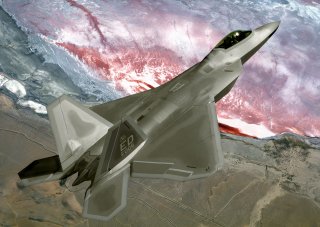Could a U.S. Fighter Jet Get Shot Down in Syria?
For the myriad forces flying over Syria, it is clear that the airspace might not be as permissive as some might have believed.
With the recent downings of an Israeli-owned Lockheed Martin F-16I Sufa and a Russian Sukhoi Su-25 Frogfoot, the question of exactly how dangerous the air environment over Syria is arises. For the myriad forces flying over Syria, it is clear that the airspace might not be as permissive as some might have believed.
“We constantly assess,” Lt. Gen. Jeff Harrigian, commander of U.S. Air Forces Central Command told reporters. “In fact I would tell you every day we are assessing the threat in the operational environment. And I say because that would include Syria or any other place that I've got my airplanes flying.”
To ensure that its aircraft are safe over Syria, the United States Air Force works very closely with the American intelligence community to assess the danger. “We are consistently working very closely with the intelligence community to fully understand what that threat is, so that I can make smart decisions and provide guidance for my airmen with respect to what those threat levels,” Harrigian said. “We provide that to the team, and I give them guidance in terms of allowable risk levels.”
Recommended: America Has Military Options for North Korea (but They're All Bad)
Recommended: 1,700 Planes Ready for War: Everything You Need To Know About China's Air Force
Recommended: Stealth vs. North Korea’s Air Defenses: Who Wins?
One of Harrigian’s responsibilities—and the General himself is a seasoned F-22 pilot who often flies operational sorties over Syria—is to ensure that his forces take risks only where appropriate “And then it's going to really depend on the situation on where we place ourselves,” Harrigian said. “And I won't get into the specific tactics we use, but I can tell you that our airmen are well prepared. We get great information from our intelligence community to inform our decisions and then we provide that to the team, so walking out the door they're ready. But clearly each situation is going to drive a different decision matrix that'll help us decide how deep into that threat we need to go.”
The Air Force is aware that every single time that it flies over Syria that it is operating inside the threat ring of an integrated air defense system (IADS). “We're constantly, every day, flying inside that integrated air defense system that is inside of Syria,” Harrigian said. “So, from my perspective, you know, as the commander, I'm responsible to make sure we fully understand what their activities are, what the patterns of life have been, and what we've seen from them in terms of how those IADS operate and how we best understand them. So, while these activities occurred, I will tell you that it's not affected our operations.”
However, while the United States Air Force has been careful and has avoided major incidents, other air arms such as the Russian Air Force and the Israeli Air Force have been less fortunate.
Harrigian did not comment on how the Israeli F-16I—a very sophisticated aircraft—could have been brought down by the Syrians. “I'm not going to speculate specifically on what we know or don't know,” Harrigian said. “I think it's important to understand that, you know, the Israelis have the right to defend themselves and any threats to their territory or their people. And so, I think that's important to remember. And, you know, quite frankly, they'll have the best information on what they believe took down that particular airplane.”
Dave Majumdar is the defense editor for The National Interest. You can follow him on Twitter: @davemajumdar.

